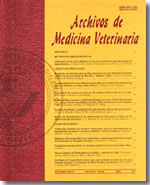Effects of artificially induced spinal cord compression on the canine cervical internal vertebral venous plexus: comparative evaluation of computed tomographic venography and digital subtraction venography
Main Article Content
Abstract
The internal vertebral venous plexus (IVVP) is a vascular network located along the vertebral canal. The present study was designed to assess variation in morphology of the cervical IVVP under experimental acute spinal cord compression in dogs. Experimental spinal cord compression was induced in 9 adult dogs at C3/4 vertebral canal level using a modified angioplasty balloon catheter technique. Dogs were evaluated prior to, during and post spinal cord compression using vertebral intraosseous digital subtraction venography (DSV) and computed tomographic (CT) venography. DS V demonstrated significant and immediate lack of opacification of the cervical IVVP at the site of compression. CT venography also demonstrated a similar lack of filling of the IVVP in areas of balloon compression. DSV images demonstrated the hemodynamic changes of the IVVP and their collateral veins during compression. During post-compression, DSV and CT venography images revealed that 5 dogs exhibited lack of filling of the cervical IVVP at the previously compressed area. Findings show that experimental spinal cord compression induces immediate local venous morphological alteration at the involved vertebral canal area.

